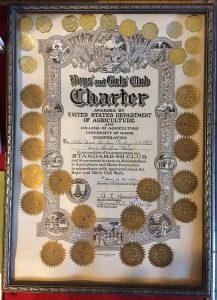4-H Club Charters
Charters were first introduced by the Federal Extension Service, United States Department of Agriculture (USDA), in late 1918 or early 1919 as a means of legitimizing Extension Youth Club Work. There are two Club Charters included in this exhibit.
- Pioneer Cooking and Housekeeping Club of Machias. The Secretary of Agriculture’s signature is very faded but is that of David F. Houston who served 1913-1920. The other signatories are Extension Director Leon S. Merrill and State 4-H Leader Ralph P. Mitchell making this probably one of the first charters issued to Maine in 1919. It holds two Achievement Seals.
- West Gorham Victory 4-H Club of West Gorham. This charter is signed by Secretary of Agriculture Henry A. Wallace, Extension Director Arthur L. Deering and State 4-H Leader K.C. Lovejoy dating it to between 1935 and 1940. It holds 32 Achievement seals.
Club Work, seen by Extension educators as highly useful in teaching improved agricultural methods to their audiences, was implemented, for the most part, in any given state through their own model(s) or through the replication of successful model(s) from other states. Such lack of standardization had widely varying results. Extension leaders wanted to standardize the 4-H Club format to increase the educational impact nationally.
To that end, national standards were developed in 1918 for 4-H Clubs. Under these standards, four requirements were suggested to define groups as “official” clubs: 1. A minimum of five members working on a similar project, 2. The presence of an adult local leader, 3. Democratically elected appropriate officers, and 4. The existence of a plan, or program of work, for the year.
Shortly thereafter the Extension Service, USDA, started issuing charters to groups that met the four requirements. These charters, although not dated, were signed by the State Club Leader, the State Extension Director, and the Secretary of Agriculture. Then, if it continued to meet these standards, and recorded the following additional accomplishments, the club would receive a National Seal of Achievement to be affixed to their charter annually. Some clubs received their initial Seal with their charter!
To receive a Seal of Achievement the clubs needed to hold at least six meetings during the year (Maine further explained that the Club secretary must keep a record of these meetings as well as the progress of each member), hold an annual exhibit, have a team that performs at least one public demonstration program in the community, attain a 60% project completion rate and hold an achievement day program. Maine also asked for the club to have a judging team chosen by competition among the members and to hold membership in the farm bureau “or other county club organization.”
State 4-H Leader Ralph P. Mitchell introduced the standards and opportunity to receive a charter to Maine 4-H Clubs in April of 1919. Clarence Day, Extension Editor Emeritus, in a 1957 unpublished history of Extension in Maine from 1910 to 1950, reported that 32 Maine 4-H Clubs received charters in 1919, four of them also receiving achievement seals. According to Day, the first Maine 4-H Club to receive a charter was the Bridgeton Girls’ Cooking and Housekeeping Club, Eva N. Howard, Leader.


